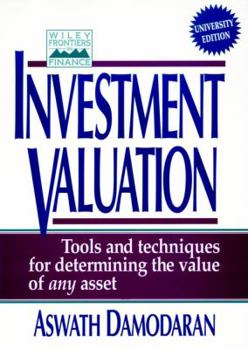Investment Valuation: Tools and Techniques for Determining the Value of Any Asset
Select Format
Select Condition 
Book Overview
Investment Valuation Tools and Techniques for Determining the Value of Any Asset Valuation is at the heart of every investment decision, whether that decision is to buy, sell, or hold. But the pricing... This description may be from another edition of this product.
Format:Paperback
Language:English
ISBN:0471112135
ISBN13:9780471112136
Release Date:October 1995
Publisher:Wiley
Length:544 Pages
Weight:2.10 lbs.
Dimensions:1.4" x 7.1" x 9.9"
Customer Reviews
5 ratings
One of the two valuation reference books
Published by Thriftbooks.com User , 20 years ago
For investors subscribed to discounted cash flows valuation (DCF), there is no other books that offer the kind of in-depth anlaysis (both in step-by-step description and available scenarios using real companies) like this book does. Plus, Professor Damodaran maintains a free website where Excel-based valuation models and industry data are periodically updated. These features make the book invaluable. In short, if I am allowed to buy only one investment book, this is the one.But since I can buy as many books as I want, it would be more important to tell what this book does not do. First, it's always important to get a second opinion. In this case, it would be something other than DCF. Currently, DCF and relative valuation (such as PE and PV) are the dominent valuation methods used in the U.S. And yes, they are both covered in-depth by this book, in addition to the Economic Value Addded method which is gaining momentum in recent years. But this book essentially dismisses the income statements in favor of cash flows statements for valuing securities, preferring DCF to relative valuation. This is certainly understandable in lights of recent manipulation of GAAP income by offenders like Enron, WorldCom and Tyco. But I believe it's important for investors to hear the voice for income statements valuation method. For that investors should get James English's Applied Equity Analysis - another must-have - as a second valuation reference book. Secondly, this book uses CAPM model for finding the discount rate. Again, it is true that CAPM is the most widely used model in the U.S., but I came to a conclusion, after reading close to a hundred critically acclaimed articles published in the last fifty years as part of my MBA requirements, that factor models provide better tracking of stock prices than CAPM does. Unfortunately, there is no good book available. For institutional investors, they can have models from BARRA and Wilshire, etc, but individual investors would have to construct their own, probably (like me) using the Fama-French three-factor model. Description of their model is available mostly from theirs and other published papers. Data are available from Kenneth French's own website at Dartmouth. Now since you read all the way through my review, here is your reward: go to Damodaran's website and download the manuscript of this book for free if you are really frugal.
Valuation Enclopaedia
Published by Thriftbooks.com User , 21 years ago
I have both the 1st edition and 2nd editions. It is the most logical and complete valuation text around. Takes you through valuation processes as well as compares various methods step-by-step, logically and rationally. I also have the McKinsey edition and although it's good, it cannot compare with Damodaran's in clarity of language and logical reasoning.
Extremely Valuable Resource!
Published by Thriftbooks.com User , 22 years ago
This is one of the very best books I have used while working on an MBA. It will occupy a prominent place on my business resources bookshelf. What makes it so special is that it covers the field of investment valuation very broadly, but each topic is handled concisely and with clarity. The author also supplies a healthy amount of context and supporting information as well as the technical matters around valuation. Another virtue is that it is laid out very well. If you are interested in a specific topic, for example valuing a company with negative earnings or a private company or even contracts for natural resources, it is easy to look up the specific information and study what is relevant to the task at hand.Plus the author has a wonderful website with supporting spreadsheets and valuable information on companies that can help a great deal in thinking through the topics raised in the book.If I could only have two or three books of all those I have used during my work at the University of Michigan Business School, this would be one of the keepers.
THE BOOK ON VALUATION !
Published by Thriftbooks.com User , 23 years ago
As far as I know there is no other book as comprehensive on the tools and techniques for valuing assets. I like in particular the concise illustration of the different DCF. Damodaran added nicely a "trouble shooting guide", which shows possible problems and solutions to the different models. If there is one thing missing, it is the missing of merger valuations.
THIS IS AN EXCELLENT BOOK ON VALUATION !!!!
Published by Thriftbooks.com User , 24 years ago
I have an MBA and work in investment banking and yet I have found Damodaran's book extremely useful. It's simply a great book on valuation that teaches exactly how to value companies by various techniques. Valuation by its very nature is a quantitative exercise. Anyone who thinks they can approach valuation in some non-quantitative fashion is just kidding themself. I highly recommend this book !!!





